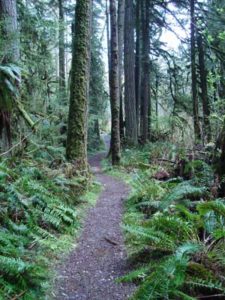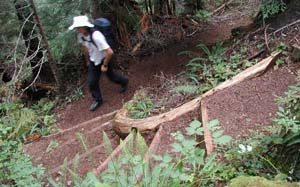Planning & Design Services
We’ve all encountered trails that are truly exceptional, leading us to places we didn’t know even existed, with amazing views or a natural setting that so dramatic or inviting it can be hard to leave. Or maybe a new trail takes us to a familiar place, and suddenly everything feels so much richer, thanks to a trail that, somehow, really works.

And we’ve encountered trails that seem mostly designed to get us from Point A to B with few frills. Some are nonetheless enjoyable to hike or saunter or cycle, as the case may be. If the trail is well designed and constructed, we’re able to move through those spaces comfortably and naturally, enjoying the experience, with few worries about becoming lost or stubbing a toe.
Plausible Concepts: Sometimes, great trails just seem to happen, almost by themselves. But chances are, someone spent a fair chunk of time imagining how that trail should be laid across the landscape, who would use it, and how it might hold up to the elements and its intended or anticipated use. In a sense, that’s really all that trail planning is: imagining. As the details begin to sort themselves out, the effort gradually transitions into plausible concepts, then actual trail design.
Our trail might be a narrow dirt path across a steep slope; or a paved or gravel rail-trail that feet, wheels and hooves can readily share; or a meandering, accessible boardwalk among the ducks, turtles and wildflowers. Coming up with a plausible concept that’s attractive, affordable and sustainable–both low-impact and low maintenance–typically comes first, well before a shovel ever hits the ground.
Design, etc: With a simple project, a formal detailed design might not even be necessary, especially when you have a qualified trail builder, experienced with sustainable design and accepted standards, available to construct the trail or offer advice. Larger or more complex projects, on the other hand, may require sorting through a host of routing and design details, options, environmental constraints, structural issues, permitting requirements, funding and construction planning.
But imagining a great trail can be the most important step in getting from no path, or perhaps a path that’s not performing well (for a myriad of reasons, to a great path that serves its purpose perfectly. Good trail planning, of course, is how we get there. Responsible trail design generally comes next, but that doesn’t have to mean busting the budget on expensive documentation or overdone amenities.

Key Questions: If a new or improved trail is in your sights, then by all means explore your options. Get to know the landscape, at least a little, and imagine the possibilities. Try to anticipate where the trail might go and how it would be used. Who will use it? Who will take care of it? What are the limits, both environmental and economic? What will we remember about the trail once we’ve returned home?
Let TrailPlanner.com help you both ask and answer these kinds of questions as you contemplate making your best ideas happen on the ground.
Contact us anytime to help you explore the possibilities.